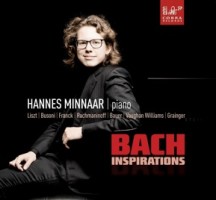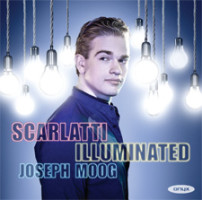(Dis)Arrangements 6. / Piano Factory 14.
|
Grant Chu Covell [April 2015.] Bach and Scarlatti on piano are intrinsically arrangements, music relocated to an instrument unanticipated by their composers. Some see Baroque music on a modern keyboard as a transgression. Might Bach have voiced chords differently for an instrument with unequal weight? Definitely Scarlatti’s technique would have expanded with plenty of leaps and hand crossings to reach all 88 keys. Some 19th and 20th-century composer-pianists found Bach and Scarlatti too spindly for the ivories. They added notes and fleshed out chords, and took other liberties such as composing new voices or adjusting harmonies. Today we can play Bach and Scarlatti’s keyboard music as written (Suites, Sonatas, etc.), transcriptions of non-keyboard works (cantatas, organ compositions, etc.), or even souped-up versions of keyboard pieces.
“Bach Inspirations.” Johann Sebastian BACH: Prelude and Fugue in A minor, BWV 543 (ca. 1708-17; arr. Franz LISZT, 1842-50); Wachet auf, ruft uns die Stimme, BWV 645 (1748; arr. Ferruccio BUSONI, 1898); Nun komm der Heiden Heiland, BWV 659 (1740-50; arr. BUSONI, 1898); Nun freut euch, lieben Christen g’mein, BWV 734 (1740-50; arr. BUSONI, 1898); Prelude, Gavotte, Gigue from Violin Partita No. 3, BWV 1006 (1720; arr. Sergei RACHMANINOFF, 1933); Die Seele ruht in Jesu Handen from Herr Jesu Christ, wahr’ Mensch und Gott, BWV 127 (1725; arr. Harold BAUER, 1944); Ach bleib bei uns, Herr Jesu Christ: Chorale, BWV 253, and Choral Prelude, BWV 649 (1748-49; arr. Ralph VAUGHAN WILLIAMS, 1932). César FRANCK: Prélude, Chorale et Fugue (1884). Franz LISZT: Fantasia and Fugue on the Theme B-A-C-H (1855; rev. 1870). Percy GRAINGER: Blithe Bells (1930-31). Hannes Minnaar (pno). Cobra Records 0038 (1 CD) (http://www.cobrarecords.com/). Minnaar enters a crowded field and fares well. This release’s highpoints are crystal Busoni transcriptions which routinely require three or more distinctly articulated voices to be convincingly passed across two hands. Nun freut euch with its rapid patter and three differently paced lines can be exceedingly difficult to bring off. Wachet auf contains one of the greatest tunes of all time, and Minnaar serves up a superlative reading of Busoni’s transcription. Perhaps unusual for Liszt, the piano transcription of the organ Prelude and Fugue, BWV 543 is not flamboyant. Every note seems directly attributable to Bach. In contrast, Rachmaninoff added questionable additions to the violin pieces, and Grainger created a very inventive ramble with Bach’s material. Vaughan Williams’ subtler liberties let Bach speak for himself. Liszt’s B-A-C-H Fantasy and Franck’s opus are meant to show off as much as reflect admiration of the Leipzig master. Close listening suggests Minnaar prefers those who have hewed closer to the originals, as his fine Busoni and Vaughan Williams attest. * * * Rachmaninoff’s extra notes, voices and adulterated harmonies neither clarify nor contribute, but rather a muddy improvisation sloshing across Bach’s clean surface. Respighi orchestrated several of Rachmaninoff’s Études Tableaux. I can only imagine the concoction had he looked to these pieces. Bach-Busoni can be grandiose, especially when left-hand octaves imitate organ pedals. Busoni also emphasized cadences with thickly spread Romantic glue. Nevertheless, Bach’s intended counterpoint and accompaniment flow. Checking in with a wide and random selection (Frederic Chiu, Anna Gourari, Vladimir Horowitz, Paul Jacobs, Murray Perahia, Mordecai Shehori, and Edna Stern), Minnaar wins hands down for clarity. Admittedly, Horowitz’s spritely Nun freut euch (EMI CHS 7 635382) from 1934 is still hard to match; Perahia (Sony SK 66511) is pretty good too. Chiu (HMU 907054) is worth a visit if only because he programs Busoni’s juiced “concert interpretation” of Schoenberg’s intentionally lean Op. 11, No. 2. The keyboard and choral items on Minnaar’s recital work best. Alessio Bax’s Bach Transcribed (Signum SIGCD156) which leans towards non-keyboard Bach originals (various Godowsky, Saint-Saëns, Siloti and Busoni transcriptions of violin, flute and cello Sonata and Partita movements, et al.) is not as successful. Grimaud’s crisper and perfunctory approach (DG B0012504-02) in Busoni’s big Chaconne from the violin Partita No. 2, BWV 1004, and just the Prelude from Rachmaninoff’s transcription of the violin Partita No. 3, BWV 1006, succeed better. Contrasting works can distract from less effective Romantic adulterations. Gourari (ECM 2255) programs Hindemith’s “1922” Suite and Gubaidulina’s Chaconne alongside two chorale preludes, the Bach-Busoni Chaconne and Siloti’s B Minor Prelude (originally from a collection for W.F. Bach).
“Scarlatti Illuminated.” Domenico SCARLATTI: Sonatas K. 135, 247, 466, 87, 96, 70, 380, 32; Sonatas K. 12, 487, 9, 519 (arr. Carl TAUSIG); Ignacy FRIEDMAN: Gigue after K. 523; Pastorale after K. 446. Walter GIESEKING: Chaconne on a Theme by Scarlatti (1939) after K. 32. Joseph Moog (pno). Onyx 4106 (1 CD) (http://www.onyxclassics.com/). A purist could listen to just the odd-numbered tracks and hear Scarlatti’s distinct notes albeit on piano. Moog is a snappy player with clean articulation and fluent with often explicit and vague Spanish mannerisms. The intricate ornaments and fussy figurations are dispatched brightly. The enhanced Scarlatti adds lines, chords to thicken the harmony and argument. As they alternate with Scarlatti’s originals, it’s easy to hear the added supporting octaves, melodies in sixths and underscored trills and cadences. These fattened piano adjustments are definitely a case of bigger as better. Tausig created six enhancements, Moog provides four. Moog alternates well between the precision required for original Scarlatti and the amplified Romantic enlargements. * * * I favor Tharaud’s Scarlatti (Virgin 50999 6 42016 2 7) for its clean and clear piano, though not as much as his Couperin. Planès’ Essercizi (Harmonia Mundi HMC 901838.39) I wanted, without success, the ca. 1800 pianoforte to unlock secrets. I am drawn more and more to Scott Ross’ Scarlatti on harpsichord. There’s a single disc, perhaps titled by Erato’s marketing department as “Best Sonatas” (Erato 2292-45423-2) which includes Ross’ likely favorite, K. 380. A 2015 reissue offers the first 30, the Essercizi per gravicembalo, K. 1-30 (Erato 08256 4619523 7). Having mentioned Horowitz, I must note that he took on Scarlatti more than once. His early 1935 attempts are outlandish. Is this how everyone played this repertoire in the 1930s? By 1951 he settled upon what we would judge today as delicate and fitting (EMI CHS 7 635382). * * * The Imp of Perversity requires me to include a recital of oboe concertos. On “Bella Napoli” (EMI 50999 5 14232 2 3), Christoph Hartmann plays music by Hasse, Cimarosa, Bellini, Donizetti, Pasculli, and D. Scarlatti. The Scarlatti entry is a string of three sonatas (K. 9, 208 and 5) arranged by Wolfgang Renz as a concerto for oboe. The sonatas’ inherent structure doesn’t introduce themes and offer the solo and ripeno moments as expected from a concerto of the period. The music’s original bite is absent from the scoring for oboe solo with strings.
Bach, Bauer, Busoni, Franck, Friedman, Gieseking, Grainger, Liszt, Rachmaninov, Scarlatti, Tausig, Vaughan Williams
[More
Bach, Bauer, Busoni, Franck, Friedman, Gieseking, Grainger, Liszt, Rachmaninov, Scarlatti, Tausig, Vaughan Williams]
[Previous Article:
Paul Bley's singular Ballads]
[Next Article:
Used Bin Troll Tweets L.]
|

